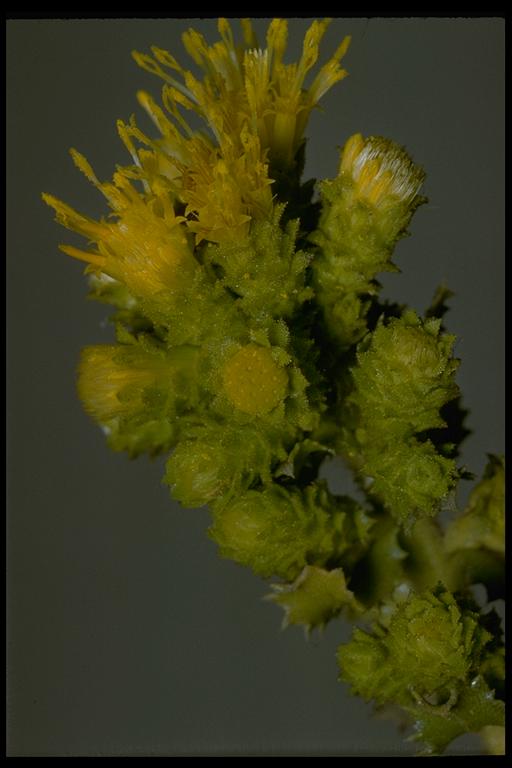Perennials, subshrubs, or shrubs, 20-250 cm (root crowns woody). Stems erect, usually much branched, glabrous or lanate-tomentose to scabrid or short-villous. Leaves cauline (deciduous); alternate; subpetiolate, subsessile, or sessile; blades 1-nerved, oblong, oblanceolate, elliptic, obovate-cuneate (often coriaceous, bases usually clasping or subclasping), margins entire or toothed, faces glabrous or densely tomentose, sometimes gland-dotted, resinous. Heads radiate, disciform, or discoid, in spiciform, racemiform, narrowly paniculiform, thyrsiform, or cymiform arrays, rarely borne singly (sessile or short-pedunculate). Involucres cylindric to turbinate or campanulate, (5-20 ×) 3-12 mm. Phyllaries 20-60 in 5-9 series, recurved or erect, 1-nerved (keeled), oblong, linear-oblong, or linear-lanceolate, unequal, herbaceous distally, margins not scarious, faces stipitate-glandular (distally). Receptacles flat, shallowly pitted, epaleate. Ray florets 0 or 3-25, pistillate, fertile or sterile; corollas yellow or drying red-purple. Disc florets 4-30, bisexual, fertile; corollas yellow, sometimes becoming red-purple, gradually ampliate from middle, tubes longer than narrowly tubular throats, lobes 5, erect, spreading, triangular; style-branch appendages usually triangular (linear in H. whitneyi). Cypselae fusiform to deltoid, subterete to compressed, 4-5-nerved, faces glabrous, canescent, or densely silky; pappi persistent, of 20-30 reddish brown, fine, smooth bristles in 1-2 series. x = 5 (4, 6).
Hazardia is restricted to the Pacific coast area of North America from Oregon through California and southern Nevada to Baja California Sur. W. D. Clark (1979) recognized three sections comprising 13 species, six of which are endemic to Mexico. All species have a chromosome number of 2n = 10 except two: H. brickellioides (2n = 12) and H. whitneyi (2n = 8). Species of Hazardia are variable in vestiture, arrays, head shape, size, and biology (ray florets fertile or sterile).
W. D. Clark (1979) treated Hazardia as a segregate of Haplopappus de Candolle; he observed that South American species of Haplopappus probably are the closest relatives of Hazardia. Haplopappus in South America (x = 5; ca. 70 species in 4 sections) has a range of variation similar to that of Hazardia. Haplopappus sect. Haplopappus and sect. Gymnocoma Nuttall are closely related to each other, forming the core of the genus in its strict sense; sections Polyphylla H. M. Hall and Xylolepis H. M. Hall, however, may be congeneric with Hazardia, based on morphologic and chemical evidence (Clark; G. K. Brown and Clark 1981, 1982). R. C. Jackson (1979) and J. Grau (1976), more conservatively, have viewed Hazardia as congeneric with the South American Haplopappus. Jackson would further include the species of Hall´s Haplopappus sect. Blepharodon [= Xanthisma sect. Blepharodon (de Candolle) D. R. Morgan & R. L. Hartman (D. R. Morgan and R. L. Hartman 2003)] within this widely defined Haplopappus.





